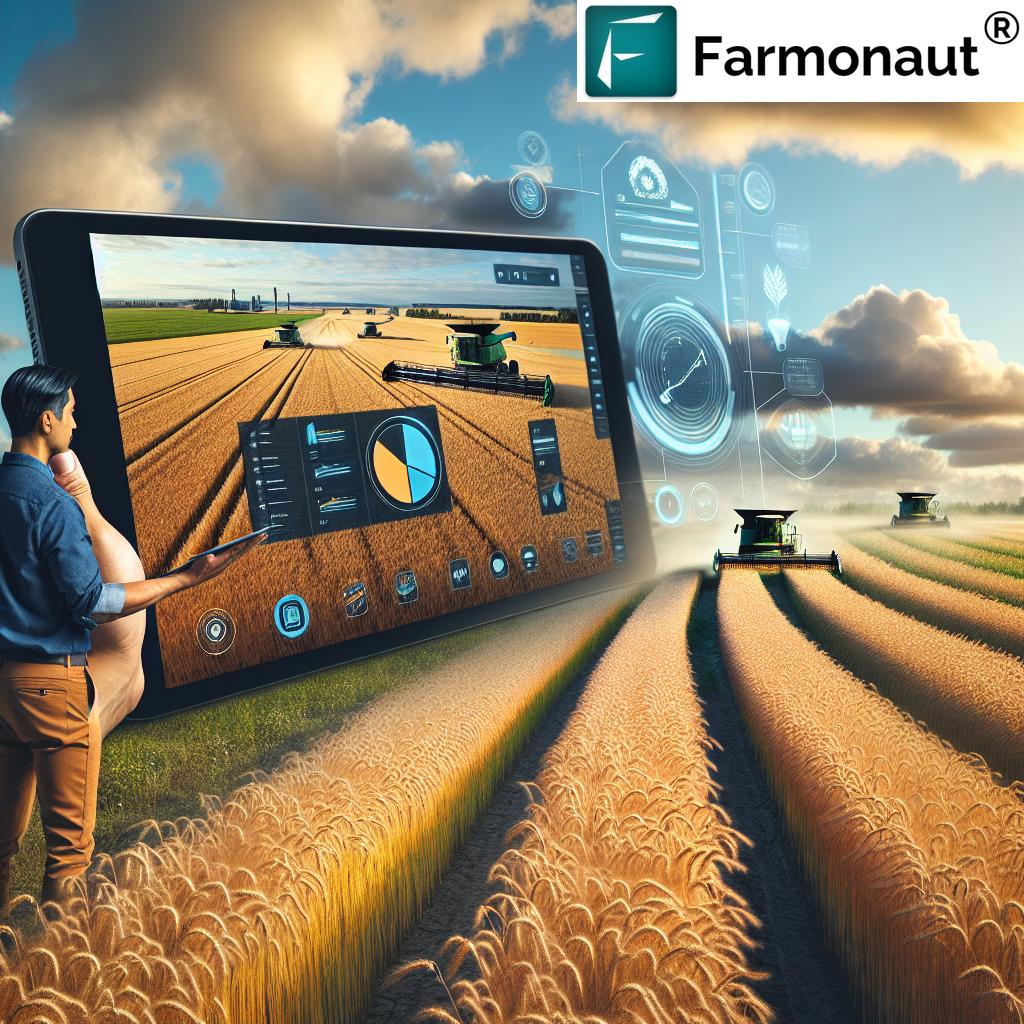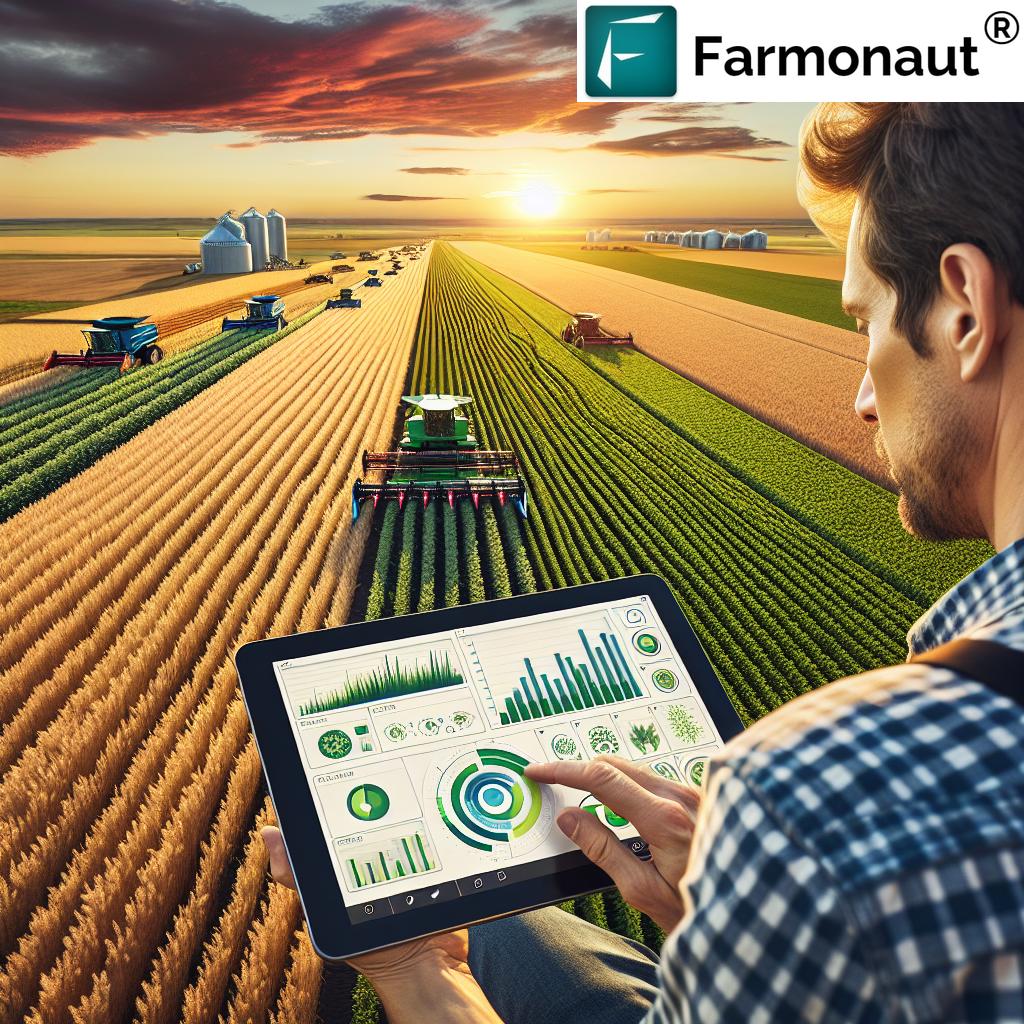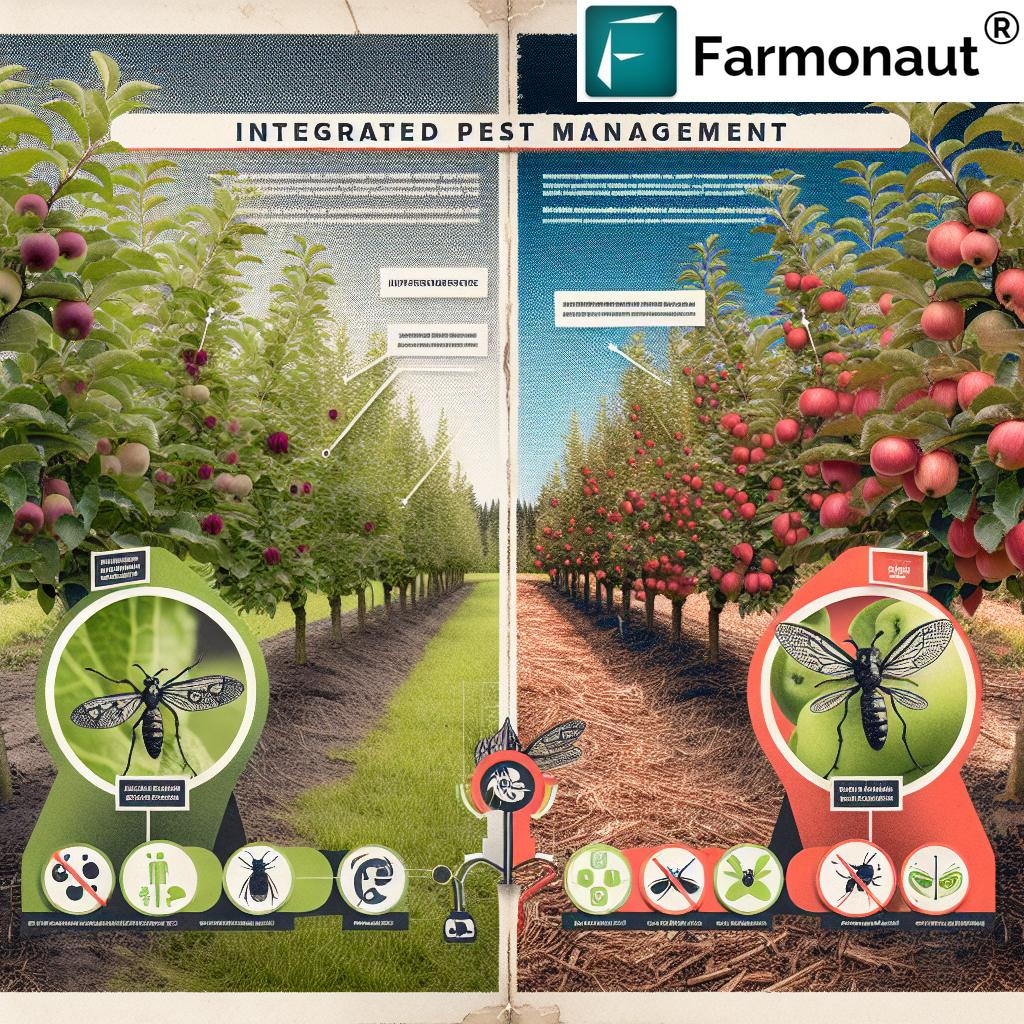Revolutionary Ag-Tech: How Bee Vectoring is Transforming Sustainable Agriculture in Canada

“Bee vectoring technology can enhance crop yields by up to 30% while reducing chemical pesticide use by 95%, revolutionizing sustainable agriculture.”
In the ever-evolving landscape of agriculture, innovative technologies are reshaping the way we approach farming and crop protection. At Farmonaut, we’re excited to explore one such groundbreaking development that’s making waves in the ag-tech industry: bee vectoring technology. This revolutionary approach is not only transforming sustainable agriculture in Canada but also setting new standards for eco-friendly crop management worldwide.
The Buzz About Bee Vectoring: A Game-Changer in Sustainable Agriculture
Bee vectoring technology represents a paradigm shift in how we approach crop protection and yield optimization. This innovative method harnesses the natural pollination behavior of bees to deliver targeted, eco-friendly fungicides directly to crops. By leveraging the power of nature, this technology addresses some of the most pressing challenges in modern agriculture, including the need for sustainable pest management solutions and the demand for increased crop yields.
How Bee Vectoring Works: Nature’s Delivery System
- Hive Integration: Special dispensers are placed in bee hives, containing organic, eco-friendly crop protection products.
- Natural Carrier: As bees exit the hive, they pass through these dispensers, picking up microscopic amounts of the product on their bodies.
- Precise Delivery: During their natural pollination activities, bees transfer these active ingredients directly to the blooms of target crops.
- Continuous Application: This process occurs throughout the flowering period, ensuring consistent protection.
This method of delivery is revolutionizing the way we think about crop protection, offering a solution that’s both highly effective and environmentally responsible.
The Benefits of Bee Vectoring in Modern Agriculture
The adoption of bee vectoring technology brings numerous advantages to the agricultural sector:
- Precision Agriculture: By utilizing bees’ natural behaviors, we achieve unprecedented precision in delivering crop protection products.
- Reduced Chemical Usage: This method significantly decreases the need for traditional pesticide spraying, leading to lower chemical residues in crops and the environment.
- Enhanced Crop Yield: The combination of improved pollination and targeted protection can lead to substantial increases in crop yields.
- Biodiversity Promotion: By reducing broad-spectrum pesticide use, bee vectoring helps maintain and promote biodiversity in agricultural ecosystems.
- Water Conservation: Unlike traditional spraying methods, bee vectoring requires no water for application, contributing to water conservation efforts.
These benefits align perfectly with the growing demand for sustainable agriculture technologies and natural pest management solutions.
Crops Benefiting from Bee Vectoring Technology
The versatility of bee vectoring technology allows its application across a wide range of crops, including:
- Blueberries
- Strawberries
- Sunflowers
- Canola
- Apples
- Tomatoes
- Caneberries
Each of these crops has shown significant improvements in disease resistance and yield when bee vectoring is implemented as part of an integrated crop management strategy.
The Science Behind Bee Vectoring: A Closer Look
At the heart of bee vectoring technology lies a sophisticated understanding of bee behavior, plant pathology, and microbiology. The active ingredients used in this process are carefully selected to be:
- Safe for bees and other pollinators
- Effective against target crop diseases and pests
- Compatible with organic farming practices
These organic fungicides and beneficial microbes work in harmony with the plant’s natural defense mechanisms, creating a robust shield against pathogens without disrupting the delicate balance of the ecosystem.
Comparing Traditional Pest Management with Bee Vectoring Technology
| Aspect | Traditional Pest Management | Bee Vectoring Technology |
|---|---|---|
| Chemical Usage | High – Broad spectrum application | Low – Targeted delivery |
| Application Method | Spraying, often with heavy machinery | Natural bee pollination |
| Precision of Delivery | Low – Widespread application | High – Directly to blooms |
| Labor Requirements | High – Regular application needed | Low – Bees do the work |
| Environmental Impact | Significant – Potential for runoff and drift | Minimal – Eco-friendly products |
| Biodiversity Promotion | Low – Can harm beneficial insects | High – Supports pollinator populations |
| Cost-effectiveness | Variable – Depends on chemical costs | High – Reduced input costs over time |
| Crop Yield Impact | Moderate improvement | Significant improvement (up to 30%) |
This comparison clearly illustrates the advantages of bee vectoring technology in terms of environmental sustainability, precision, and overall effectiveness in crop protection.
Explore how Farmonaut’s satellite technology complements innovative agricultural practices: Web App | Android App | iOS App
The Global Impact of Bee Vectoring Technology
While bee vectoring technology has its roots in Canada, its potential for global impact is immense. As the world grapples with the challenges of feeding a growing population while minimizing environmental impact, innovations like this are crucial. The technology is gaining traction in various parts of the world, with trials and implementations happening across North America, Europe, and parts of Asia.
“Canada’s innovative bee vectoring approach is transforming pest management for over 20 different crops, including blueberries, strawberries, and sunflowers.”
International Partnerships and Collaborations
The success of bee vectoring technology has led to numerous international partnerships and collaborations. Research institutions, agricultural organizations, and governments worldwide are showing keen interest in this Canadian innovation. These collaborations are crucial for:
- Adapting the technology to different crops and climates
- Conducting field trials in diverse agricultural settings
- Sharing knowledge and best practices across borders
- Accelerating the global adoption of sustainable agriculture technologies

Regulatory Landscape and Approvals
The journey of bee vectoring technology from concept to commercialization has involved navigating complex regulatory landscapes. In Canada, the technology has received approval from the Pest Management Regulatory Agency (PMRA), paving the way for its commercial use. Similar regulatory processes are underway in other countries, with the technology gaining approvals in key agricultural markets.
Key Regulatory Considerations:
- Safety for bees and other pollinators
- Environmental impact assessments
- Efficacy in disease and pest control
- Compatibility with existing agricultural practices
- Residue levels in harvested crops
These rigorous approval processes ensure that bee vectoring technology meets the highest standards of safety and effectiveness, building trust among farmers, consumers, and regulatory bodies alike.
The Economic Potential of Bee Vectoring
The economic implications of bee vectoring technology are significant, offering potential benefits across the agricultural value chain:
- For Farmers: Reduced input costs, improved crop yields, and potential premium pricing for sustainably grown produce.
- For Consumers: Access to crops with lower chemical residues and potentially higher nutritional value.
- For the Environment: Reduced chemical runoff and support for pollinator populations, contributing to overall ecosystem health.
- For the Ag-Tech Industry: New avenues for innovation and development in sustainable agriculture technologies.
As the technology gains wider adoption, we anticipate seeing a positive impact on local economies, particularly in regions where agriculture plays a significant role.
Challenges and Future Developments
While bee vectoring technology shows immense promise, it’s not without its challenges. Some of the key areas for ongoing research and development include:
- Expanding the range of crops and pathogens that can be addressed
- Optimizing the formulation of bio-controls for different climates and conditions
- Integrating bee vectoring with other precision agriculture techniques
- Addressing concerns about the impact on wild bee populations
- Developing strategies for use in greenhouse environments
These challenges present opportunities for further innovation in the field of agricultural biotechnology and sustainable farming practices.
Discover how Farmonaut’s API can enhance your agricultural data analysis: API | API Developer Docs
The Role of Precision Agriculture in Bee Vectoring
Bee vectoring technology represents a significant advancement in precision agriculture. By combining this method with other cutting-edge technologies, we can create highly efficient and sustainable farming systems. Some complementary technologies include:
- Satellite imaging for crop health monitoring
- IoT sensors for real-time field data collection
- AI and machine learning for predictive analytics in pest and disease management
- Drone technology for targeted interventions
The integration of these technologies with bee vectoring can lead to even more precise and effective crop management strategies.
The Future of Farming: Integrating Bee Vectoring with Advanced Technologies
As we look to the future of agriculture, the integration of bee vectoring with other advanced technologies presents exciting possibilities. At Farmonaut, we’re particularly interested in how satellite-based farm management solutions can complement and enhance the effectiveness of bee vectoring technology.
Potential Synergies:
- Satellite Crop Monitoring: Using satellite imagery to assess crop health and identify areas that may benefit most from bee vectoring treatment.
- AI-Driven Predictions: Employing artificial intelligence to predict disease outbreaks and optimize the timing of bee vectoring applications.
- Blockchain Traceability: Implementing blockchain technology to track the use of bee vectoring and provide transparency throughout the supply chain.
- Data-Driven Decision Making: Utilizing comprehensive data analytics to fine-tune bee vectoring strategies for maximum effectiveness.
These technological integrations could further enhance the precision and efficiency of bee vectoring, leading to even greater improvements in crop yields and sustainability.
The Role of Education and Adoption
For bee vectoring technology to reach its full potential, education and widespread adoption are crucial. Key areas of focus include:
- Training programs for farmers and agricultural professionals
- Public awareness campaigns about the benefits of bee vectoring
- Collaboration with agricultural extension services
- Integration into agricultural education curricula
By fostering understanding and acceptance of this innovative technology, we can accelerate its adoption and maximize its positive impact on sustainable agriculture.
Conclusion: A Buzzing Future for Sustainable Agriculture
Bee vectoring technology represents a significant leap forward in our quest for sustainable, efficient, and environmentally friendly agricultural practices. By harnessing the natural behavior of bees, we’re not only improving crop yields and reducing chemical use but also supporting biodiversity and ecosystem health.
As this technology continues to evolve and integrate with other advanced agricultural solutions, its potential to transform global farming practices is immense. From the fields of Canada to farms around the world, bee vectoring is paving the way for a more sustainable and productive agricultural future.
At Farmonaut, we’re excited to be part of this agricultural revolution, offering complementary technologies that can work in harmony with innovations like bee vectoring. Together, these advancements are shaping the future of farming, ensuring food security while preserving our planet for generations to come.
Frequently Asked Questions (FAQ)
- What is bee vectoring technology?
Bee vectoring is an innovative crop protection method that uses bees to deliver eco-friendly fungicides directly to plant blooms during pollination. - How does bee vectoring benefit farmers?
It reduces chemical usage, improves crop yields, enhances sustainability, and provides precise delivery of crop protection products. - Is bee vectoring safe for bees?
Yes, the products used in bee vectoring are specifically designed to be safe for bees and other pollinators. - What crops can benefit from bee vectoring?
Bee vectoring can be used on various crops including blueberries, strawberries, sunflowers, apples, and more. - How does bee vectoring compare to traditional pesticide application?
Bee vectoring is more precise, uses fewer chemicals, and has a lower environmental impact compared to traditional spraying methods.
Farmonaut Subscriptions













